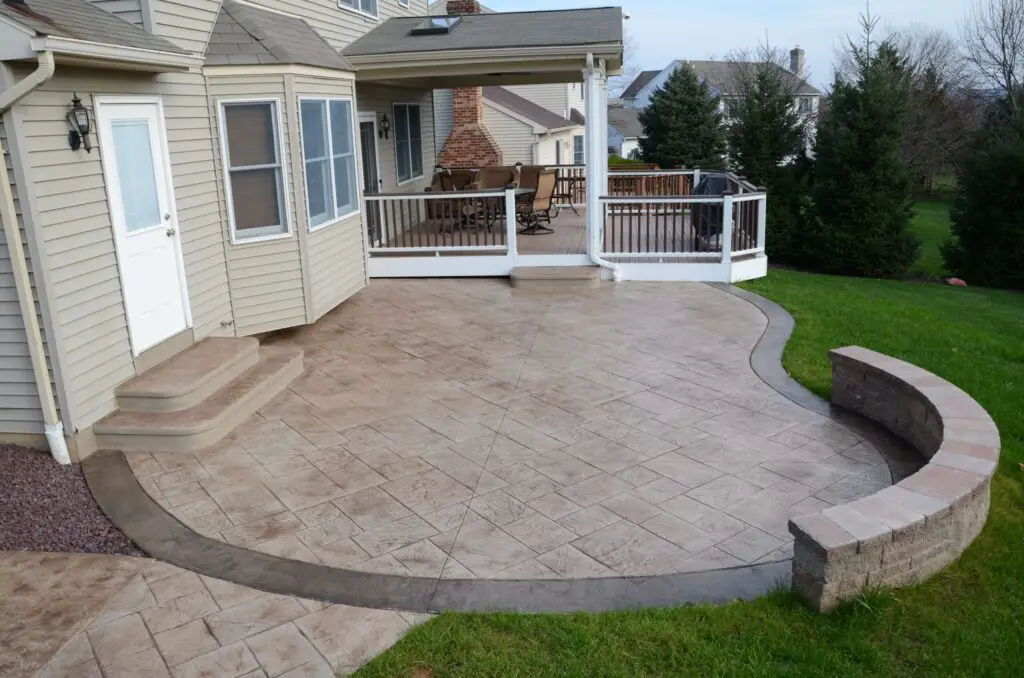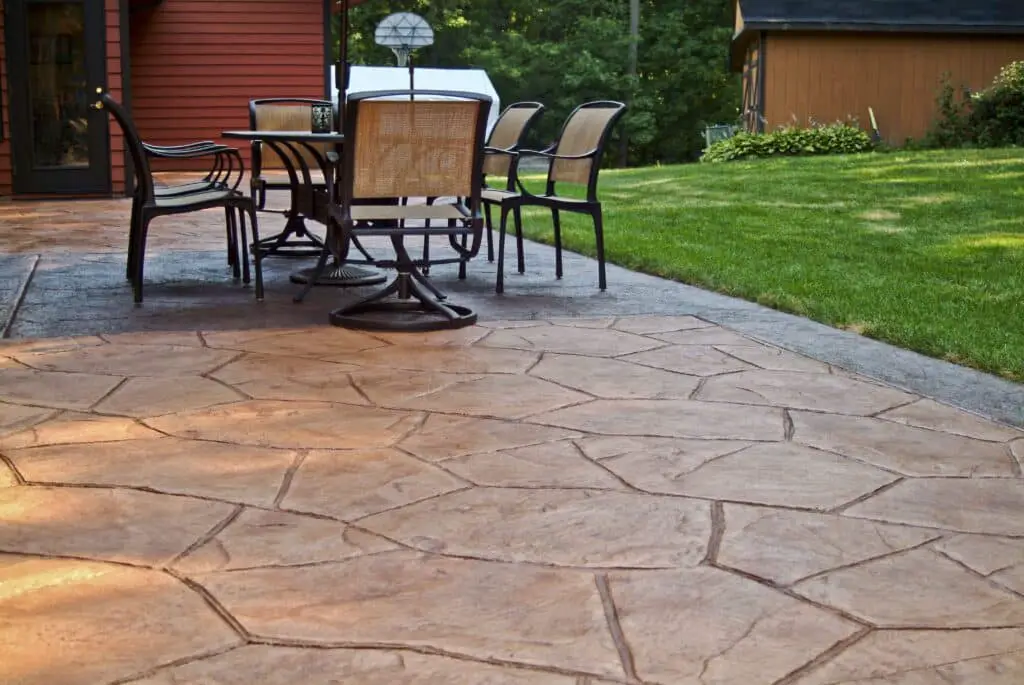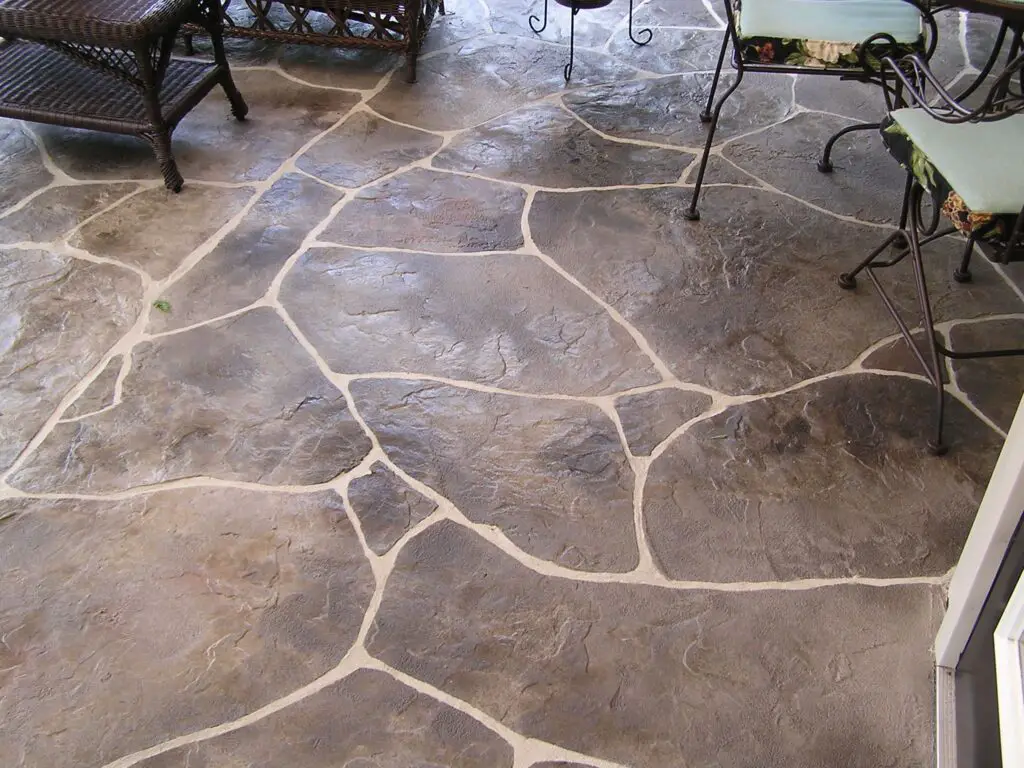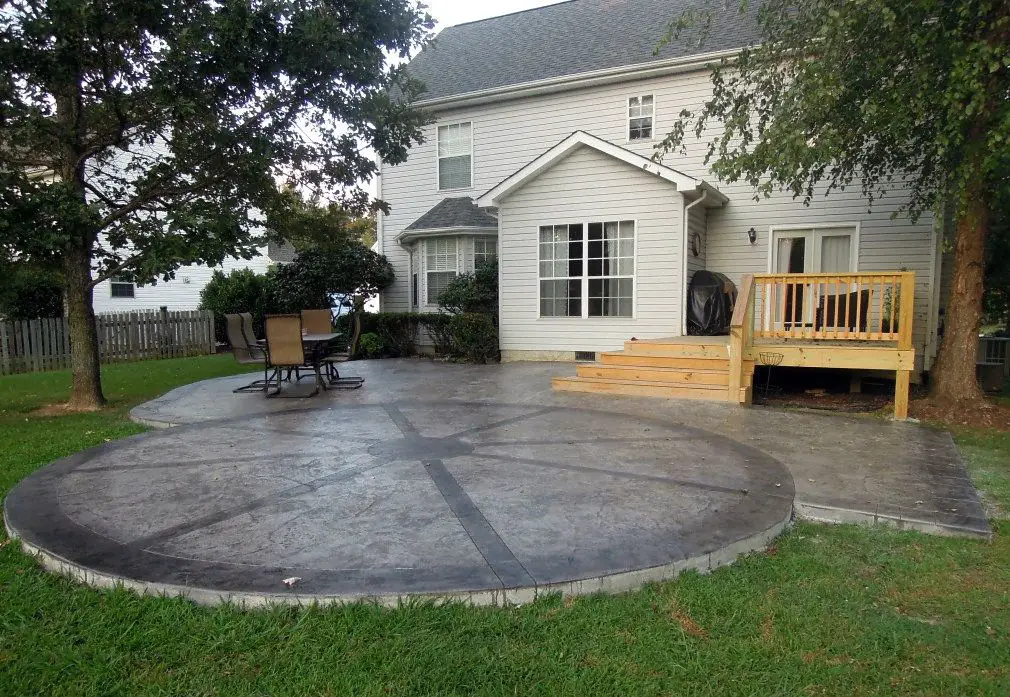How To Stamp Concrete Patio
Introduction
How To Stamp Concrete Patio: Like any successful project, a solid foundation is essential. Before diving into stamping, you need to prepare the existing concrete patio surface. This involves thorough cleaning, repairing any cracks or damages, and ensuring the area is free from debris. A clean canvas ensures better adhesion of the stamping materials and results in a smoother finish. The beauty of stamped concrete lies in the ability to mimic various patterns and textures. There are countless stamping patterns available, ranging from classic brick and cobblestone to more intricate designs like slate or natural stone.
A release agent is a crucial component in the stamping process. It prevents the stamping tools from sticking to the concrete and allows for a clean release. Choose a release agent that complements your chosen color scheme and enhances the overall hang string appearance of the stamped surface. When selecting colors, consider the style of your home and the surrounding landscape to achieve a cohesive look. Sealers also add a subtle sheen, enhancing the patio’s visual appeal.
Work with ready-mix concrete or create a custom mix, depending on your requirements and the size of the patio. Pour the concrete evenly over the surface and level it out using appropriate tools. Proper curing is essential for the concrete to develop strength and durability. Protect the freshly stamped patio from direct sunlight and excessive moisture during the curing process. Once cured, apply a high-quality sealer to protect the surface from stains, fading, and wear.

What’s the best way to stamp concrete?
How to Stamp Concrete
- Apply color hardener.
- Apply release agent.
- Check concrete’s plasticity.
- Pretexture the edges of the slab.
- Begin placing stamp mats.
- Continue placing stamps.
- Do detail or touch up work.
- Remove residual release agent and apply curing compound.
The key to a successful stamped concrete project lies in meticulous preparation. Start by thoroughly cleaning the concrete surface and removing any debris, stains, or sealers. Repair any cracks or imperfections and ensure the area is level and stable. Adequate preparation provides a clean canvas for the stamping process and ensures better adhesion of the stamps and coloring agents.
The timing of the stamping process is critical for achieving sharp and clean impressions. Start stamping as soon as the concrete reaches the right consistency – neither too wet nor too dry. Test the concrete’s readiness by pressing your finger gently into the surface; if it leaves a slight impression without sticking to your finger, it’s time to begin stamping. Delaying the process may result in uneven patterns or difficulty in creating seamless textures.
How do you make stamped concrete?
- Step 1: Preparing Model for PMC-780 Dry.
- Step 2: Dispensing and Pouring PMC – 780 Dry.
- Step 3: Demold PMC-780.
- Step 4: Pouring and Preparing Concrete.
- Step 5: Using PMC – 780 Stamps At Job Site.
- Step 6: Cleaning up and Finish of Project.
Start by thoroughly cleaning the existing concrete surface, removing any dirt, debris, grease, or old sealers. A clean surface ensures better adhesion of the new concrete layer and results in a more professional finish.
Inspect the concrete for cracks, chips, or other damages. Repair these imperfections using appropriate concrete patching materials to ensure a smooth and even surface.
To prevent the stamps from sticking to the concrete, apply a release agent over the entire surface. The release agent also adds color variation and enhances the final appearance of the stamped concrete.
Select a high-quality concrete mix suitable for stamping. You can opt for ready-mix concrete or create a custom mix, depending on your project’s requirements and the climate in your area. Control joints are deliberate cuts or grooves made in the concrete surface during the installation process.
Follow the manufacturer’s instructions to mix the concrete, ensuring the right water-to-concrete ratio. Thoroughly blend the ingredients to avoid air pockets that could weaken the final product.
Pour the mixed concrete evenly over the prepared surface. Use screeds and bull floats to level the concrete and create a smooth, flat slab.
What is better than stamped concrete?
When designing a patio, walkway or driveway, many homeowners have a difficult time choosing between stamped concrete and pavers. In short, concrete pavers are a much better choice for a variety of factors.
Stained concrete provides a more subtle and organic appearance compared to stamped concrete. It enhances the existing concrete surface by adding translucent, semi-transparent color variations, giving it a more elegant and sophisticated look.
Unlike stamped concrete, stained concrete does not have a patterned texture, making it a preferred choice for those seeking a cleaner and more contemporary aesthetic.
Exposed aggregate concrete exposes the natural beauty of the aggregates (pebbles, stones, or other materials) within the concrete mix. This results in a visually appealing surface with a textured, non-slip finish.
What is the powder used for stamped concrete?
Powder release is used with stampable overlays, stamped concrete and wall stamp mixes. It creates a barrier between the wet cement and the stamping tool and prevents the stamping tools from creating “puckers” at the surface that greatly detract from the finished product.
This process enhances the concrete’s appearance, providing a vivid and long-lasting color that mimics the look of natural materials like stone, brick, or slate.
Dry-shake color hardener allows for precise color control and uniformity. With a wide range of available colors, it is possible to match or complement the existing design and aesthetics of the surrounding environment.
Besides its decorative function, dry-shake color hardener strengthens the surface of the concrete. It forms a dense, abrasion-resistant layer that can withstand heavy foot traffic and exposure to the elements.
Quality dry-shake color hardeners contain UV-resistant pigments, ensuring the color remains vibrant and resistant to fading over time. By bonding with the concrete’s surface, the color hardener accentuates the stamped texture, adding depth and realism to the finished product.

How thick is stamped concrete?
Four inches
How thick is stamped concrete? Our standard slab is a minimum of four inches. Some situations will require us to pour six inches of concrete, and this would be discussed before the project takes place. Stamped concrete is simply a decorative slab that is more likely to crack due to its low PSI. On the other hand, concrete pavers typically don’t crack, but should a paver ever break, replacing a single paver is much easier than having to replace an entire section of stamped concrete. Concrete is a versatile construction material made up of a mixture of cement, water, and aggregates (such as sand, gravel, or crushed stone). When these ingredients are combined and allowed to cure, they form a solid and durable material suitable for various construction projects.
The thickness of stamped concrete is directly related to its load-bearing capacity. If the stamped concrete will be subjected to heavy loads, such as vehicle traffic on a driveway or a patio with outdoor furniture, it needs to be thicker to withstand the pressure and prevent cracking.
The soil conditions at the site of the stamped concrete installation also play a role in determining the thickness. If the soil is unstable or has a lower load-bearing capacity, the concrete may need to be thicker to provide sufficient support and prevent settling or sinking.
In regions with freezing temperatures and a significant freeze-thaw cycle, it is advisable to use thicker stamped concrete. The freeze-thaw process can cause expansion and contraction, which may lead to cracking. A thicker concrete layer can better withstand these temperature changes.
Local building codes and regulations often specify the minimum thickness required for various concrete applications. It’s essential to adhere to these guidelines to ensure the structural integrity and safety of the stamped concrete.
Can you turn regular concrete into stamped concrete?
The first step is to prepare the existing concrete surface. It should be clean, free from debris, grease, or any existing sealers. If there are any cracks, chips, or imperfections, they should be repaired using appropriate concrete patching materials.
Before applying the stamped concrete overlay, a bonding agent is applied to the existing concrete surface. The bonding agent ensures proper adhesion between the old and new concrete layers, creating a strong bond.
The overlay is spread evenly across the existing concrete using trowels or other application methods. The thickness of the overlay can vary, typically ranging from 1/8 inch to 3/8 inch.
After applying the overlay, the stamping process begins. It serves as a structural element in construction and is typically used for functional rather than decorative purposes. Control joints are deliberate cuts or grooves made in the concrete surface during the installation process. They are strategically placed to control where the concrete will crack naturally, directing the cracks along these joints rather than randomly across the surface. Stamps with various patterns and textures are pressed into the wet overlay to create the desired design. The stamps are carefully placed in a repeating pattern to achieve a seamless and natural look.
Does stamp concrete crack?
Myth #3: Stamped concrete will start to crack and break down before you know it. Stamped concrete isn’t going to last forever. It will, eventually, start to crack and break down just like any other kind of concrete. Stamped concrete, on the other hand, is a specialized form of concrete. It contains the same basic ingredients as regular concrete, but it also incorporates color pigments and texture enhancements. Control joints are deliberate cuts or grooves made in the concrete surface during the installation process.
Properly spaced control joints can help reduce the occurrence of unsightly and potentially damaging random cracks.
The base and subbase on which the stamped concrete is poured play a crucial role in preventing cracking. A well-prepared and compacted base helps distribute the load evenly and reduces the chances of settlement and subsequent cracking.
The concrete mix used for stamped concrete should have the appropriate proportions of cement, aggregates, and water to achieve the desired strength and durability. A well-designed mix can help resist cracking and ensure a more robust finished product.
In areas prone to heavy loads or where extra strength is needed, reinforcing materials such as steel or synthetic fibers can be added to the concrete mix. Reinforcement helps improve the concrete’s tensile strength, reducing the likelihood of cracking.
What is the difference between concrete and stamped concrete?
Stamped concrete, on the other hand, is a specialized form of concrete. It contains the same basic ingredients as regular concrete, but it also incorporates color pigments and texture enhancements. Control joints are deliberate cuts or grooves made in the concrete surface during the installation process.
Plain concrete has a smooth and relatively plain appearance. The texture is typically flat and lacks the intricate patterns and designs seen in stamped concrete.
Stamped concrete offers a wide range of textures, patterns, and designs, making it highly customizable. It can replicate the appearance of various natural materials, such as cobblestone, slate, tile, or even wood. Stamped concrete provides the visual appeal of these materials without the higher costs associated with using them.
Regular concrete is versatile and used for a broad range of applications, including foundations, sidewalks, driveways, floors, and more. It serves as a structural element in construction and is typically used for functional rather than decorative purposes. Control joints are deliberate cuts or grooves made in the concrete surface during the installation process.
Stamped concrete is primarily used for enhancing the aesthetic appeal of surfaces. It is commonly used in patios, pool decks, walkways, and other outdoor areas where decorative elements are desired. While it can still provide functional use, its main purpose is to add visual interest to the surface.

Conclusion
Preparation is vital, and taking the time to clean, repair, and plan the design will ensure a smooth and successful stamping process. The selection of stamps and colors is an opportunity to let your creativity shine, allowing you to create a custom look that complements your home’s style and landscape. During the stamping process, attention to detail and proper technique are crucial to achieving a natural and seamless pattern.
Working with the right timing, using various stamps concrete, and adding realistic textures will elevate the final appearance of your patio. Regular maintenance is equally important to preserve its beauty over time, making sweeping, cleaning, and occasional resealing essential tasks.
Whether you choose to embark on this project as a DIY enthusiast or enlist the help of a professional, stamped concrete patios offer an exceptional way to express your artistic vision and create an inviting outdoor space for relaxation and entertainment. Remember, stamping concrete patios can be a labor-intensive task, and it may require some practice to achieve the desired results. If you’re unsure about tackling this project on your own, consider hiring a professional concrete contractor who has experience in stamping concrete.








